We covered in the article right here how to squat only using resistance bands, your body and nothing else. But a bar or a barbell is actually a great tool you can use to combine with resistance bands.
In this article we will cover how to perform squats with a bar and resistance bands. Using a small bar and only add resistance through bands as well as doing traditional weight training and pimping it with resistance bands.
We start by showing you the right way of doing squats, with both only using resistance bands and combining them with weights. In the second part of the article we then cover some Do’s & Don’ts and great tips to help you maximize your performance and get a great workout. In case you want to incorporate bands into your training with your barbell, we have an in depth article about this topic for you right here.
Bar Squats With Resistance Band
Then here we go, let’s see how combining bands and bars gonna look like.
Band VS Weights & Machine
Doing your squats with a resistance band gives you several advantages over doing them with a free weights. But you can also reap these benefits by introducing resistance bands to your weight training.
- Don’t leave results on the table! You are leaving results on the table by using either the wrong resistance bands or the wrong workout plan. No worries, we got you covered – take our free workout plan tailored for your goals here and make sure to check out our perfectly tuned set of resistance bands here.
- Follow the natural strength curve of your muscle! The resistance of a band will always increase the more you stretch it and that’s also the natural strength curve of your muscle, having the most power in the full contraction.
Especially in the starting position (bottom position) we are weaker than in the finishing position (top position). Bands are perfect, since they provide less resistance at the start of the movement and maximize the resistance at the end where we are the strongest. - Fewer Injuries & Home Workout! You probably don’t have a home gym with a lot of weight at your disposal and doing squats with weights take quite a lot of time to develop the right technique to be able to handle more weight without risking injury – with resistance bands you can do squats at home with minimal equipment and very safe, since band force you to perform the exercise in a good form simply by using them. Automatic injury prevention. Nice!
- Versatility! With one band you can simulate a variety of resistances depending on the stretch and also use it to train your whole body.
There are also more reasons to favor resistance bands over traditional free weights or machines, or simply incorporating them in your weight training like reducing the stress on your joints, getting more peak contraction, and many more. But we’re talking here about doing a squat, so if you’re interested in background info about what benefits resistance bands give you in strength training and muscle building, check it out here.
How To Bar Squat The Right Way Only Using Resistance Bands
Some people prefer to have a bar in their hand when working out. This is actually a valid reason. With a bar you are more stable and can generate more force especially if you’re new to training with resistance bands. The only downside is getting into position without a squat rack, since you need to get the bar over your head on your upper back (back squat) or at least on your shoulders (front squat). This is especially hard with higher resistance.
There are a lot of pricey choices out there if you’re looking for a bar which you can use for resistance band training. I never had any of those. And I don’t see a reason to getting one. The 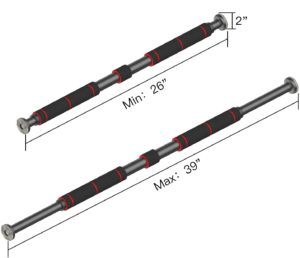 reason is simple you can have the same and even more for a fraction of the price those manufacturers ask for. In the beginning I simply used a thicker wooden staff. Since it is only a tool for fixing your band to and to simulate a barbell, it is more than enough. Further down the road I discovered an even better alternative. A simple doorway pull up bar. You can use it for pull ups… Obviously… And as a bar for resistance band training. The best thing…it has even padding.
reason is simple you can have the same and even more for a fraction of the price those manufacturers ask for. In the beginning I simply used a thicker wooden staff. Since it is only a tool for fixing your band to and to simulate a barbell, it is more than enough. Further down the road I discovered an even better alternative. A simple doorway pull up bar. You can use it for pull ups… Obviously… And as a bar for resistance band training. The best thing…it has even padding.
There are 6 simple steps to perform a squat with perfect form, and they don’t change even if you use a bar:
- Fix the band(s) to the bar and step with both feet on the band – Stance width around shoulder wide
- Grab the bar and lift it up over your head on your upper back
- Take a big breath and hold it
- Initiate the movement by bending your knees and driving your hip backwards
- Go down until your thighs are parallel to the ground (if you can go further down, even better)
- Explode back up into a full stand
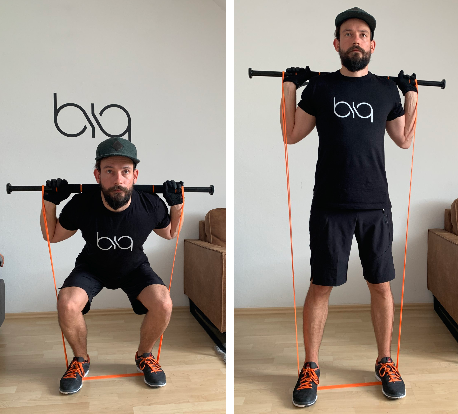 The front squat set up is also great and especially easy to get into, since you don’t need to lift the bar over your head.
The front squat set up is also great and especially easy to get into, since you don’t need to lift the bar over your head.
How To Squat By Combining Resistance Bands And Weight Training
The biggest advantage of doing squats with weights is having a squat rack. A rack allows you to start in the top position without first getting the bar over your head or in your front squat position. With that said you can still have a great legs workout with bandy only and without a squat rack. But if you have access to a rack and weights add bands. You won’t believe how well these two tool are complimenting each other. You basically combine the two benefits of both words. Constant resistance with bands, to compensate the small disadvantage of bands in the bottom position. And the linear variable resistance of band, which overload your squat in the top position. Try it and see how you squat performance will blow up.
Now how do you set it up? Most racks have pins at their base for exactly the reason to be able to attach bands. For squats, I would recommend doubling up the bands. You will have a ton of added resistance at the top, since you need two bands with this set up. Take a thicker band and attach it to the bar as shown in the picture. If you need more resistance simply wrap it around the bar as many times as you need to.
There is actually a reverse set up you can try with bands. Especially great if your lacking point is getting out of the bottom position with higher loads you can handle without a sweat more towards the top. Attach the bands at the top of the rack and wrap them around the bar. Now you basically have a spotter without needing to ask anybody. The bands will support you by pulling harder at the bar the lower you go.

We have the best workout plan for resistance band training out there - and you can get it for free!Answer the 4 questions below and we send it to you, no strings attached!
Alternative Set Ups
If your rack doesn’t have any pins at the bottom to attach your bands to, you can simply make the cross set up with your body. Take two bands and make the following. Step on one band with one foot ant bring the band to the oppisite shoulder by lifting it over your head. Now repeat for the other side. Now you have the band tension and the weigth.
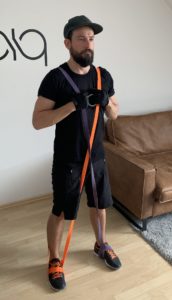
The alternative would be hanging the bands over the bar and stepping in each band with one foot before lifting the bar off the rack. This takes a little more time to get used to. Best practice with lighter weight first. And once your body gets used to the little details you have to think of, add more weight and go from there.
Important Do’s & Don’ts!!!
 ⓵ Straight Lower Back And Neutral Neck – these are the most-common mistakes with this exercise and even might hurt your lower back if you do it with high resistance. Make sure to keep your lower back straight. Just keep thinking about it while performing the squat and it will already better your form. The second tip is keeping your neck in a neutral position by looking at a point on the ground around 6 feet in front of you. This will also help keeping your lower back straight. Rounding your lower back creates uneven force on your spine and this is the reason injury can occur.
⓵ Straight Lower Back And Neutral Neck – these are the most-common mistakes with this exercise and even might hurt your lower back if you do it with high resistance. Make sure to keep your lower back straight. Just keep thinking about it while performing the squat and it will already better your form. The second tip is keeping your neck in a neutral position by looking at a point on the ground around 6 feet in front of you. This will also help keeping your lower back straight. Rounding your lower back creates uneven force on your spine and this is the reason injury can occur.
⓶ No Slack – when you’re in the bottom position of your squat, there shouldn’t be any slack in the band. The band should be stretched a little bit so you feel a force pulling you down a little bit. If you have a slack here you will lose a lot of time under tension!
If it is not possible for you to stand up completely without having a slack at the bottom position you need to use a lighter resistance band (below you find tips how to increase the force with a lighter resistance band).
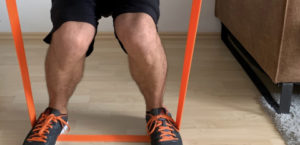 ⓷ No Internal Rotation Of The Knees – rounding of knees internally is another common problem while performing squats. This usually happens to a lot of beginners or if the load is way too heavy. So make sure to choose a resistance you can handle and to actively push your knees outside.
⓷ No Internal Rotation Of The Knees – rounding of knees internally is another common problem while performing squats. This usually happens to a lot of beginners or if the load is way too heavy. So make sure to choose a resistance you can handle and to actively push your knees outside.
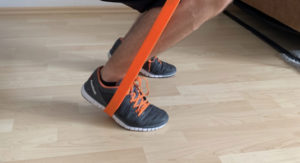 ⓸ Keep Your Heels On The Ground – especially if your new to the squat this might happen in the beginning. This might have two reasons. Bad ankle mobility or not driving your hips back enough. Simply focusing on keeping your heels at the ground will help already a lot. In case you have problems with this in the beginning, you can take 2 thin books and place them underneath your heels.
⓸ Keep Your Heels On The Ground – especially if your new to the squat this might happen in the beginning. This might have two reasons. Bad ankle mobility or not driving your hips back enough. Simply focusing on keeping your heels at the ground will help already a lot. In case you have problems with this in the beginning, you can take 2 thin books and place them underneath your heels.
Get Your Pump
If that doesn’t get you that pump, here are some tips that will help you work that butt and thighs to the ground.
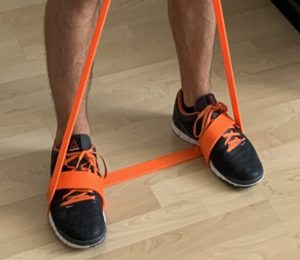 Shorten The Band – many people make the mistake to use a band with a resistance level that’s simply too high for the exercise. The full effect of bands results from getting the right resistance and if you use a band that’s too heavy you can’t get a clean range-of-motion and clean reps and get lower progress.
Shorten The Band – many people make the mistake to use a band with a resistance level that’s simply too high for the exercise. The full effect of bands results from getting the right resistance and if you use a band that’s too heavy you can’t get a clean range-of-motion and clean reps and get lower progress.
Instead of taking a stronger band simply shorten the band, you use and you can do that perfectly by wrapping it around your hand or foot once or twice and get the extra resistance without losing the ability to do clean reps.
That’s also one reason why I don’t like the resistance bands with handles attached to it and prefer the loop-style bands.
Double Time – If you feel that there is only a little bit of resistance missing and a jump to the next thicker band would be too much, simply add a second one of the lighter ones. It will give just that extra resistance you’re looking for without taking it over the top.
Time Under Tension – compared to weights where you have the same force applied to any position of the movement, bands will add more resistance the further you stretch them – this will lower the time under tension your muscle has during a set in the starting position. Focus on doing the exercise controlled and try to hold it for a second or two in the fully contracted position and don’t let the band snap back but slowly go back to the starting position.
Full Lower Body Workout
Simply doing Squats is not a full lower body workout as there are multiple muscles working in your legs and glutes – we have here a full lower body workout with different exercises that will give you the strongest pump you can ever think of and keep you healthy for years to come – check it out here.





